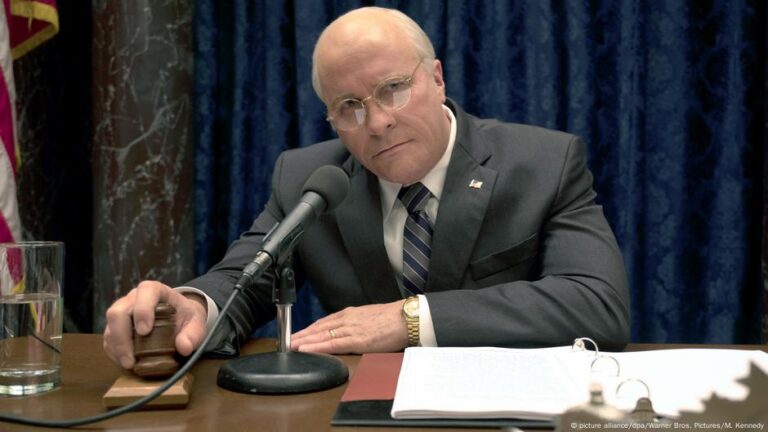With the death of Dick Cheney, the United States bids farewell to a vice-president — he served under President George W. Bush from 2001 to 2009 — who defied the usual Hollywood stereotype of the post. Vice-presidents, when they appear on film and TV, are usually cast as the bit-players, as politically inert or, at most, as comic relief.
Cheney was something else. Widely seen as the real power and driving force of the Bush presidency, and as the architect of the US invasion of Iraq, Cheney came to symbolize American policy and power in the post-9/11 era. Not in a good way. His nickname in the press at the time was “Darth Vader.”
But whatever you thought of his politics, Cheney did inspire two of history’s finest cinematic depictions of Veep-dom.
‘Vice’: Christian Bale’s spectacular transformation
The most famous is Adam McKay’s “Vice” (2018), a darkly comic biopic starring Christian Bale as Cheney that charts his rise up the Washington ranks, from Wyoming congressman to defense secretary to what the film presents as the most powerful vice president in US history.
In McKay’s depiction, Cheney is the puppeteer: the quiet voice in the corner of the room whose suggestions become policy.
It’s another full-on performance from Bale, who transformed for the role, gaining more than 40 lbs (some 20 kilos) and acting through layers of prosthetics and make up.
The film was nominated for eight Academy Awards, including a best actor nomination for Bale, but won just the one, for that extraordinary hair and makeup work.
Cheney claimed to have never watched the film, but said his granddaughter’s verdict was that Bale made him look “like a real badass.”
A Machiavellian figure in Oliver Stone’s ‘W.’
Before “Vice,” Oliver Stone took a crack at depicting the Cheney-Bush dynamic in his 2008 dramedy on the life of the 43rd President, “W.”
Richard Dreyfuss plays Cheney to Josh Brolin’s clueless “dub-ya.” While Bush is the star, Cheney is the dark force steering the ship of state. He’s the shadow lurking the corner of the Oval Office, a whispering Machiavellian quietly pushing the president towards war.
“W.” is less polished than “Vice,” but is arguably a more pointed portrait of Cheney as the power behind the throne.
Fictional vice presidents, from stoners to heroic figures of power
Compared to these two commanding Veeps, most of Hollywood’s fictional vice presidents fall short. Dax Shepard as Vice President Frito Pendejo (apologies to our Spanish readers) in Mike Judge’s “Idiocracy” (2006) is a perpetually-stoned, hilariously incompetent lawyer who stumbles into the second-highest office in the land.
Julia Louis-Dreyfus as Selina Meyer, the VP in HBO’s political satire “Veep” (2012-2019) is one of TV’s great comedic performances — she won six Emmys in a row for the role — but Meyer, who is simultaneously ambitious, clueless and shameless, is unlikely to win over any swing voters.
Nor is Frank Underwood, the ruthless politician, played by Kevin Spacey, in HBO’s “House of Cards” (2013-2018), who rises through the ranks, from House of Representatives majority whip, through the vice presidency, to take the top job, using all the tools available, from treachery and deception to murder.
His scheming wife, Claire (the excellent Robin Wright) is little better. Claire becomes VP in Frank’s second term and then President after Underwood is forced to resign in disgrace (when Spacey was written out of the series following his own very public scandals).
Underwood’s brand of power-hunger maneuvering seems inspired by Cheney’s real-life reputation for stealth maneuvering, though even his worst enemies would never have accused the late Vice President of throwing his journalist lover under a train (as Underwood does in “House of Cards” season 2).
The rarer vice-president portrayal is that of the steady hand in crisis. It’s the version of the office we get from Glenn Close in Wolfgang Peterson’s action classic “Air Force One” (1997), when Close, as VP Kathryn Bennett, has to hold the line politically after President James Marshall (a heroic Harrison Ford) is taken hostage by Russian terrorists.
Morgan Freeman gives a similarly stoic performance in the B-movie “Olympus Has Fallen,” as Allan Trumbull, a solidly-competent Veep who steps up after terrorists (North Koreans this time) take out the man at the top. The scenarios bear little resemblance to reality, but at least they invert the cliché of the powerless second-in-command.
On screen, Veeps real and imagined still lean towards the absurd and the grotesque, either the villain in the shadows or the clueless dude in a suit. But Dick Cheney, who turned the vice presidency from a ceremonial afterthought into an instrument of power, has also helped change how Hollywood imagined the role of vice president. Before him, the veep was a supporting act. After him, he (occasionally) became the story.
Edited by: Elizabeth Grenier


